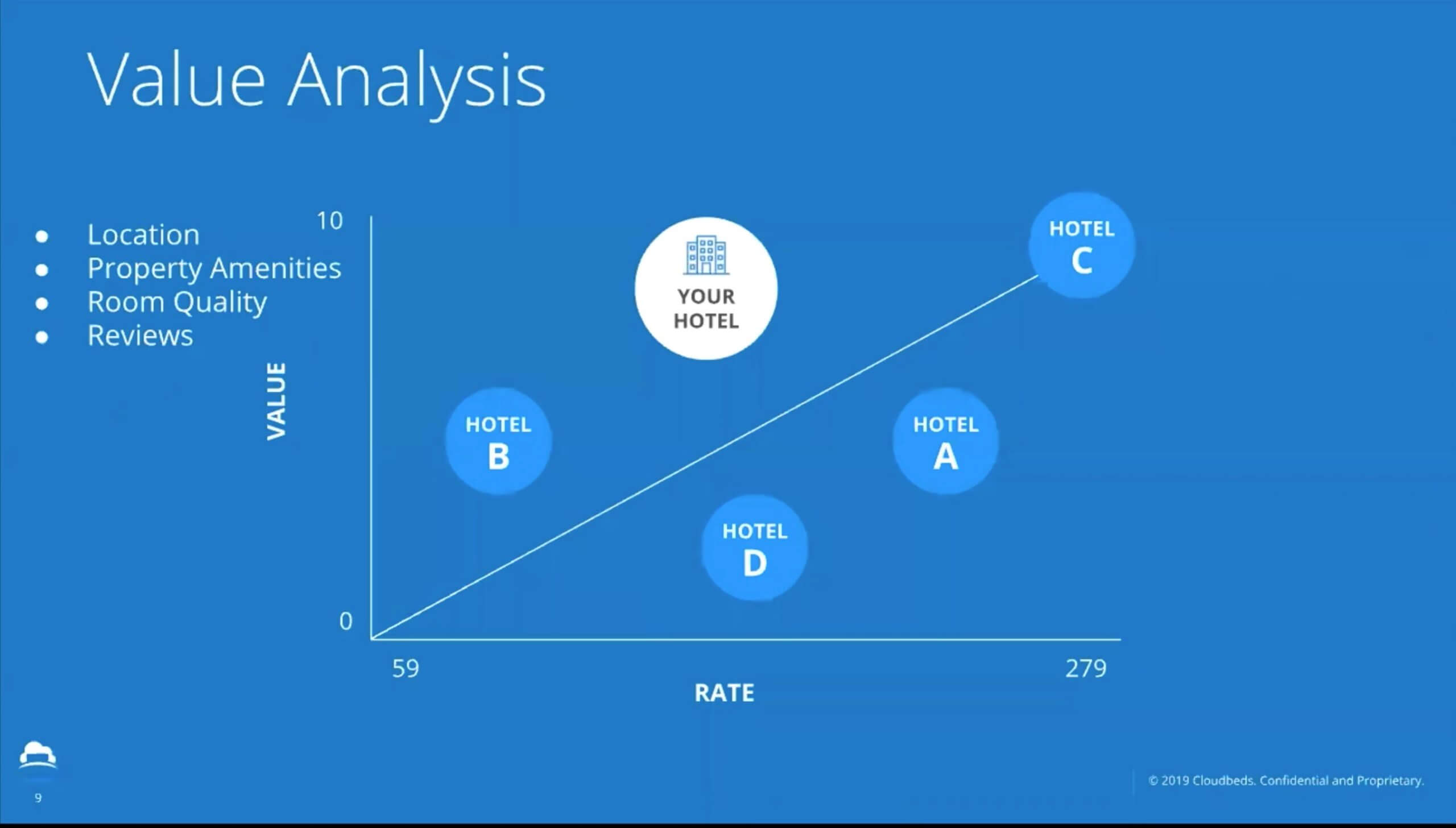
By Rafael Blanes
Have you ever wondered if your hotel is priced correctly? Ever looked across the street and wondered why that hotel has a full parking lot?
In the hotel industry, as with other industries, we can use competitive analysis to gauge the market. Let’s talk about what a hotel competition analysis is, why you should perform one, and how to do it.
What is a hotel competitive analysis?
A hotel competitive analysis is an assessment of your competitor’s strengths and weaknesses as a means of comparison to find your property’s strategic position in the market. Hoteliers use competitor analysis to help benchmark the local market to find their competitive advantage and ideal pricing position.
It’s basically like studying the chessboard in preparation for the game ahead. How do you know what move to make next? Gathering information on your competitors’ pricing can give you the insight to make smart revenue management decisions. Endgame: checkmate.
Why is performing a hotel competitive analysis important?
A hotel competitive analysis (sometimes called a value analysis) gives you the information you need to ensure your property has a competitive edge. It prevents you from leaving money on the table with rates that are too low or losing occupancy due to too high rates. If you’ve ever worked on strategic planning for business growth or a marketing strategy, you may have done a SWOT analysis or an evaluation of your business’s strengths, weaknesses, opportunities, and threats.
Similarly, in the hospitality industry, a hotel competitor analysis helps you find your “sweet spot” in your local market. The saying knowledge is power has never been more true when it comes to your competition; without this knowledge, you’re giving up your power to be in control of the best pricing strategy for your market.
How do you do a hotel competitive analysis?
Let’s start by discussing what is included in a hotel competition analysis. Two major factors impact hotel rates the most: what your competitors are doing and your current occupancy.
Large hotel chains, like Hilton and Marriott, have the budget to hire a revenue manager. Revenue management can be time-consuming and expensive, and it requires an understanding of data and strategic decision-making. However, it’s no longer true that revenue management is only for larger hotel businesses with a full hotel management staff.
Every property type and accommodation provider should conduct a hotel competitive analysis if they want to see better revenue per available room (RevPAR), a higher average daily rate and increase their profitability.
The 6 steps of a hotel competitive analysis
1. Choose your hotel competitive set, also known as a hotel compset. Select 3-5 direct competitors in your market (in our example, we use 4). For an accurate comparison, choose properties that attract a similar target audience and potential guests as your property.
2. List the competitive characteristics for comparison (in our example, we chose the 4 characteristics listed below and illustrated in the table), then on a scale of 1-10, rate where each property falls on the scale:
- Location
- Property amenities
- Room quality
- Reviews (number and star rating)

3. Take an average of those scores to calculate the “perceived value” of the property.
4. Next, take an inventory of your compset’s average room rates: Note down both the cheapest rate and the highest rate you found publicly listed for each property.
5. Plot the results on a graph (view image) On the “x-axis” add the RATE by listing the cheapest rate to the highest rate found for all the properties. On the “y-axis” add the VALUE which is the average score you calculated for each property in Step 3.
6. Review the results to build your compset strategy. The graph will help you understand your competitive position in the market. In other words, where you “stack up” against your competition in terms of price and perceived value.
For a truly comprehensive view of your hotel’s performance, you may also want to create secondary compsets. Secondary compsets allow you to get a big picture view by including hotels that are not necessarily in your “true competition” but are still influenced by the shifts in your market.
Choose a few luxury hotels of a higher price point with more offerings if you aspire to emulate them someday (for example, you have an impending renovation), or choose a compset of properties in a lower-tier, like budget hotels, so that you know how they are reacting to market changes to make well-rounded decisions for your property.
How to optimize your pricing using the results of your hotel competitive analysis
Consider the image for the example we used: theoretically, your hotel should be on the line to have the ideal rate for its perceived value. In the example, “Hotel B” and “Your Hotel” are not charging as much as they should.
However, if a hotel with a higher value than your property sets a lower rate, you will have to lower your rate too, or else that property will win over more direct bookings. Mapping out who is underpricing and overpricing their property is valuable in helping you stay as close to the middle line as possible.
Watch a step-by-step video of how to conduct a hotel competitive analysis:
Make smarter pricing decisions with PIE
As mentioned earlier, two primary factors drive yield: your competitors’ rates and your occupancy. Cloudbeds’ Pricing Intelligence Engine (PIE) gives you real-time industry data so you can stay informed of local market rates, giving you more opportunities to maintain optimal pricing and improve your yield management strategy.
Want to know when your competition raises or lowers their rates? Get alerts when your competitors change room pricing. You can also set rules to trigger alerts when your property’s occupancy changes so you can adjust your rates accordingly. The all-in-one insights dashboard gives you a centralized overview of your pace, pick-up, occupancy, and performance at a glance.
PIE’s functionality allows you to set rules and alerts to support your property’s unique rate strategy. You can’t spend every minute on yield management, so PIE does it for you. These rules give you 24/7 control over your pricing so that you don’t miss an opportunity to increase your hotel revenue.
A rule can trigger an alert based on booking patterns, allowing you to manually approve changes according to your goals. Also, a rule can automatically take action on your behalf based on the criteria you set. Or you can set up an alert so that you can make a decision about whether or not to raise/lower your hotel pricing. The key is that you now have the data you need to make informed decisions.
Where PIE wins is in pricing. It helps you answer a few key questions:
- What’s going on at your property in terms of pricing and occupancy?
- What is your compset doing?
- How are you pacing, and should you move your rates?
PIE’s three primary rule types to help you manage your revenue strategy:
1. Occupancy-based. This type of rule triggers a rate adjustment when occupancy is greater or less than a certain percentage. As your occupancy goes up, you’ll want to raise your rates to maximize your revenue. The last few seats on the airplane are usually the most expensive because demand is high. PIE can help capture the highest revenue (increasing your ADR) for your last rooms.
Maybe you know that every time your hotel reaches 60% occupancy, you want to raise the rate by 10%. You can set it and forget it, and let PIE take the reins on making that change. There’s also a date range option so you can apply the rules only to a certain number of days out or to only select specific dates (such as special events or holidays). Occupancy-based rules can be set on the property’s overall occupancy or even by certain room types.
2. Compset-based. We’ve come a long way from counting cars in parking lots to check occupancy or calling the front desk of competitors to ask what their rate is. Also gone are the days of spending countless hours online checking competitor rates on OTAs like Booking.com or Expedia. PIE will track your competitors and alert you when they change their pricing strategy. Have your eye on one specific property? Set a customized alert for that specific hotel so you know when they adjust their rates.
3. Restriction-based. Optimize your revenue by staying fully booked and preventing “orphan nights.” For example, if you have a 3-night minimum length of stay (minLOS) restriction over the weekend, and Friday and Sunday are booked up, this rule will remove the restriction to help fill the last couple of hotel rooms on a Saturday night. This rule type builds flexibility into managing your calendar and prevents stay restrictions from limiting revenue opportunities.
You know your market best, so when a rule or alert is triggered, PIE is there to present the data in an easy-to-use way so you can make informed pricing decisions – not guesses. There is no limit to the number of rules and alerts you can have. Some properties use dozens at a time! It’s up to you to decide what works best for your individual property in your unique market.
The PIE revenue management system works seamlessly with Cloudbeds’ integrated platform of hospitality management tools, including an award-winning property management system (PMS), channel manager, and booking engine. Typically, properties using PIE see an average increase in ADR of 10-12% and achieve their ideal price position online 44% more of the time than their competitors.




















